LED headlight bulbs
Replace halogen bulbs with LED headlight bulbs
If you’re contemplating replacing your halogen headlight bulbs with LED headlight bulbs, think again.
You’ve probably heard they’re brighter. They’re not.
You may have heard they do a better job of lighting up the road. They don’t.
There are lots of myths out there about retrofitting LED headlight bulbs into a headlight designed for halogen headlight bulbs. There isn’t a single LED headlight bulb that will cast more light on the road or throw it farther down the road than the type of bulb specified for your vehicle by the carmaker. Here are the facts about retrofitting LED headlight bulbs in a halogen headlight. What you’re about to read is based solely on the law and light physics and not opinion.
First, Retrofitting LED bulbs into a headlight designed for halogen bulbs is NOT legal.
The U.S. Department of Transportation sets the standards in the U.S. for headlight bulbs in the Federal Motor Vehicle Safety Standard #108. If the carmaker designed the headlight to accept halogen bulbs, that’s the only bulb you can legally install. It doesn’t matter which state you live in or whether you have reflector-style or projector style headlights; to meet D.O.T lighting standard #108 you must use the bulb the headlight was designed for.
That’s because the design, size, location, lumens and flux of the light source must match the reflector/project design exactly in order to get the proper beam pattern and light intensity on the road. You can’t change just one component and get the same beam pattern, no matter how much you re-aim the headlight assembly.
So a factory-installed projector headlight assembly that meets DOT #108 specifications and is certified by the carmaker to accept a an H11 halogen capsule bulb, for example, cannot, under any circumstances be fitted with either an H11 compatible HID or LED bulb and be legal. Period.
As an aside, tests conducted by the Society of Automotive Engineers (SAE) show that LED bulbs actually throw LESS light on the road, despite the fact that the LED manufacturers advertise higher lumen output levels than halogen bulbs. For details on the SAE technical paper, see this post.
Aftermarket LED bulbs don’t carry a DOT certification
There aren’t any LED bulbs that carry a DOT certification for use in a halogen headlight assembly, even though some LED bulb claim they “meet current regulations.” In fact, an LED bulb for use in a halogen headlight can’t possibly meet current regulations because those headlights can only use halogen bulbs.
To get around this illegality, some LED bulbs state they’re approved for “off-road use only.” That should be your warning that you can’t install them for use on normal roads.
Read the D.O.T letter at the end of this story and read about the legal liability issue here. The lawsuit mentioned is about tail-lights, but the liability issue is the same: If you change the lighting from the factory and it causes an accident you are liable.
Why drivers want LED headlight bulbs
Drivers switch to LED bulbs for three reasons:
• They want brighter headlights so they can see better at night. LED bulbs advertise more lumens than halogen bulbs, so you’ll think they’ll actually put more light on the road.
• They believe the specs that show a much longer lifespan.
• They like the fact that they use less energy.
Unfortunately, LED bulbs don’t perform as advertised. Read on to find out why they don’t throw more light on the road and don’t last nearly as long as their specs claim.
Many LED bulbs don’t fit into factory headlight assemblies
Most LED bulbs have a fairly large heat sink on the connector side of the bulb. The heat sink assembly often interferes with the fit under the hood and often prevent the re installation of the factory headlight cover.
LED bulbs DON’T throw more light ON THE ROAD
Here’s where the irony comes into play. Even though LED bulbs claim they output more lumens than a halogen bulb, when placed in a headlight assembly designed for halogen bulbs, the majority of the light winds up in the foreground (the area right in front of your car, not down the road), in the trees, or as glare in oncoming traffic. But they don’t throw more light on the road!
LED bulbs can’t work properly when installed in a halogen headlight assembly.
A tungsten filament is a coil of wire. It has length and width and is 3-dimensional, so it emits light in a 360° pattern
LED bulbs generate light from multiple circuit-on-board (COB) chips placed in on two sides of the circuit board.
To come close the matching the halogen bulb, an LED bulbs should at least have the same size and shaped light source as the halogen bulb, but most don’t. Even if the LED bulb does have the same shape and is placed exactly the same focal length, it still will won’t illuminate the road properly. It can’t because a COB LED bulb is really two 2-dimensional light sources (one above the frame and one below) that are incapable of projecting light 360° like a filament. That means they can never work the same in a reflector or projector headlight designed for a single filament.
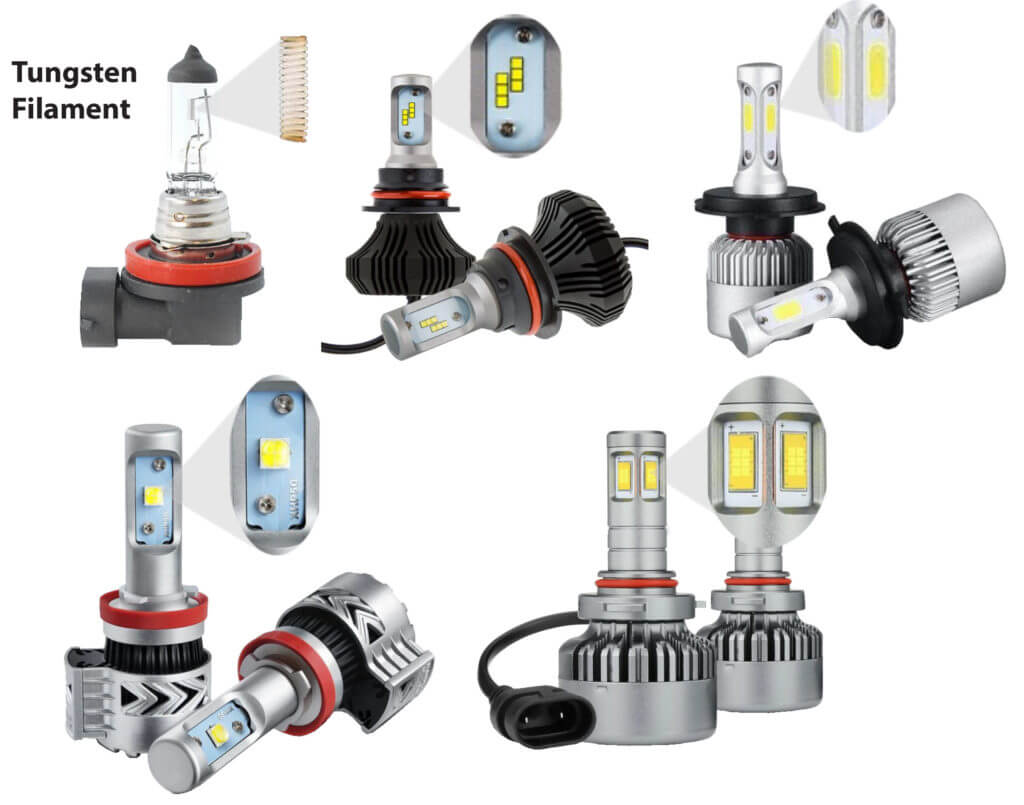
Most LED headlight bulbs don’t match the size, shape and focal length as the halogen bulb. Because of that, they can’t even come close to matching the beam pattern of a halogen bulb.
Neither a reflector headlight nor a projector headlight can compensate for light scatter coming off the reflector from an LED bulb with 2-dimensional light sources.
LED headlight bulbs don’t work in a projector headlight
LED headlight bulb sellers claim their bulbs work in projector style headlights because projector headlights are less dependent on the reflectors. That’s false. All projector headlights have a reflector. They work differently than an ordinary reflector style headlight, but they still have a reflector and the bulb must match the reflector. Here’s why.
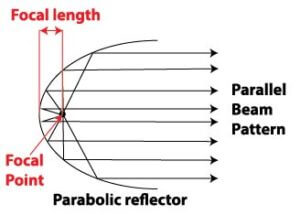
This image shows a halogen bulb in a halogen headlight assembly. Notice how the parabolic reflector focuses the light into a direction straight-ahead pattern.
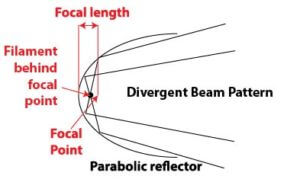
Same reflector but different light source location. Notice how the reflector can’t reflect the light the same way.
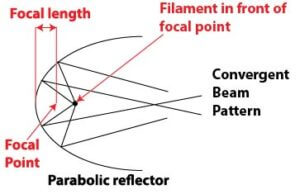
In this image, you see what happens if the light source is moved away from the reflector. The result is more light shining into oncoming traffic and the trees, and down towards the road—but not forward.
The reflector in a project headlight focuses the light to a midway point between the reflector and the lens. The lens then refocuses/projects the light down the road for maximum illumination. Once again, the reflector used in a projector headlight is designed for whatever bulb was installed at the factory. Change the bulb and you change everything.
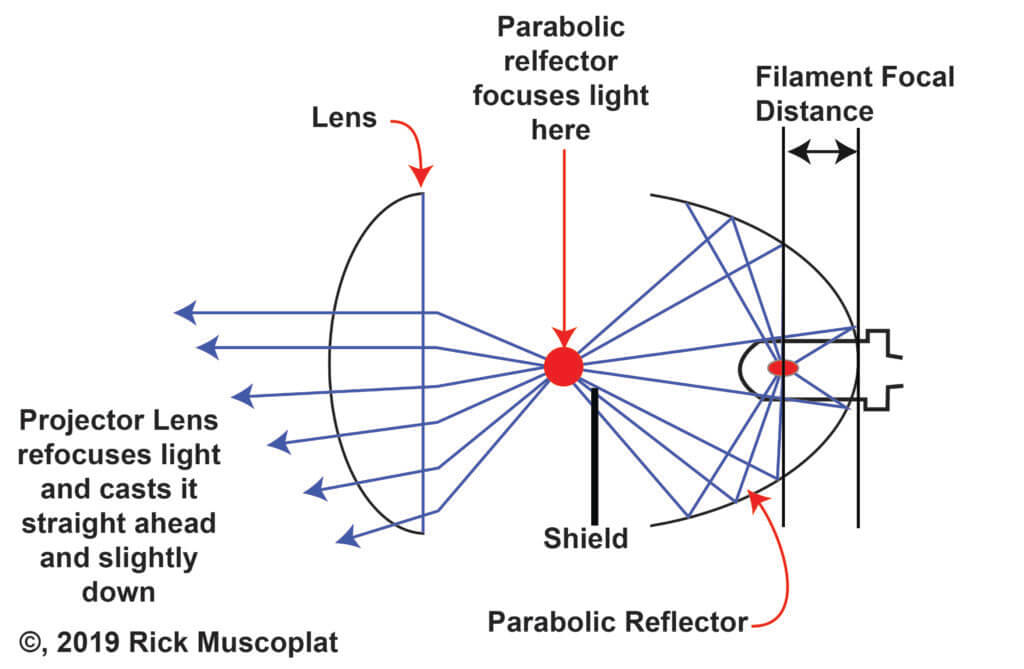
Projector headlight with halogen bulb. The reflector focuses the light midway and the lens refocuses it.
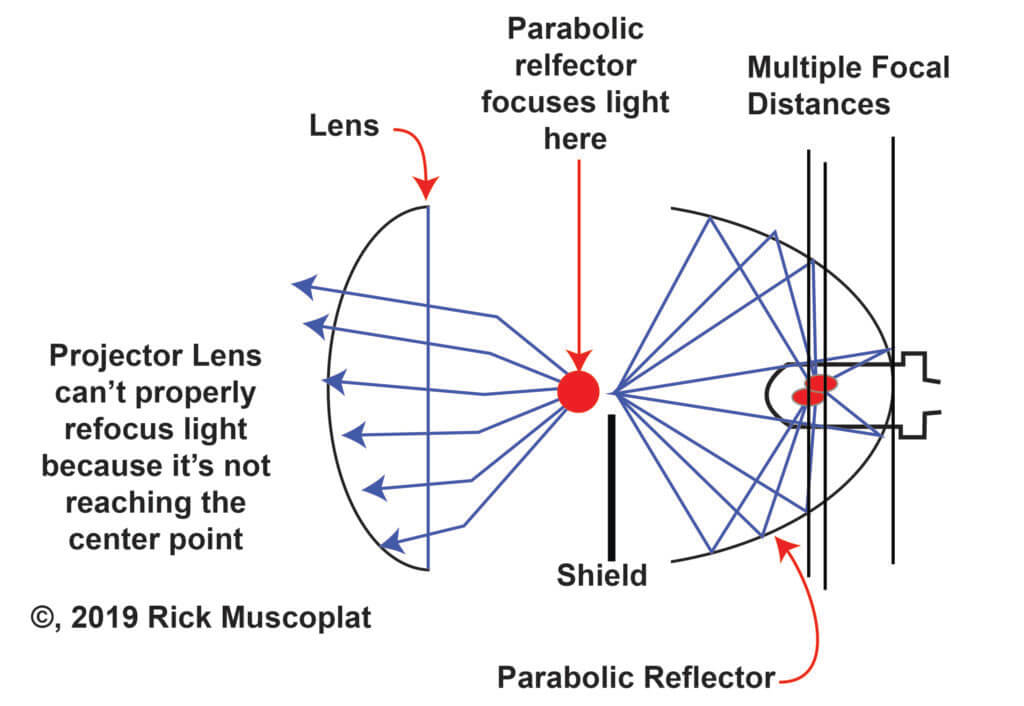
Change the bulb and the beam no longer focuses midway between the reflector and the lens. So less light gets refocused on the road and since the focus is off, more light ends up as glare.
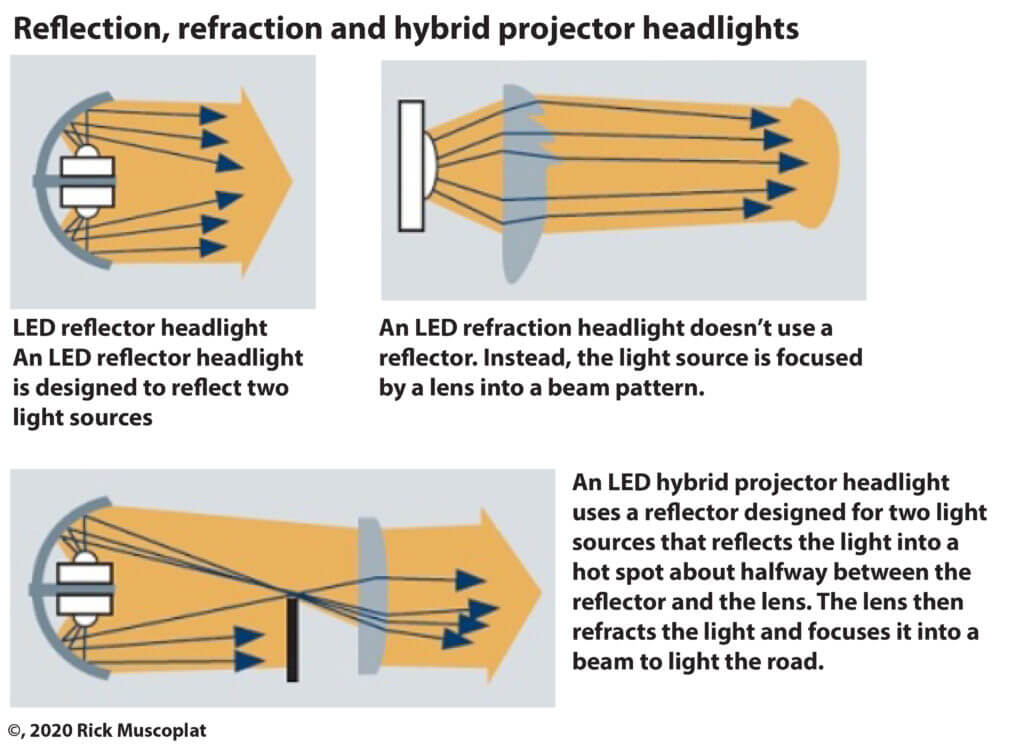
Scroll down to see how a reflector/bulb mismatch causes a projector headlight to cast less light on the road.
When you get caught by the law
Why do I mention the law? Because the police can stop you if your headlights cause glare. The glare gives you away.
LED headlight bulbs expose you to legal liability
The glare you throw into oncoming traffic can cause accidents. If your LED retrofit bulbs cause glare and that glare causes an accident, YOU can be sued for not driving with illegal and non-compliant headlights. Oregon State Police Senior Trooper Douglas Brown states, “I’ve had cases where they’ve swerved across into the oncoming lanes and hit the car that was blinding them.”
LED headlight bulbs are notoriously unreliable
LED bulbs have large cooling fins that extend outside the headlight assembly to cool the electronics. They’re far more expensive to buy and they tend to fail faster than standard halogen bulbs. The estimated life (in hours) never quite matches the actual life once in the vehicle. Put it all together; less light on the road, more glare for oncoming traffic, higher cost, and shorter life and it just doesn’t make sense to convert to LED headlight bulbs.
For the doubting Thomases
Here’s a legal interpretation of the law from the legal counsel of the National Highway Traffic and Safety Administration:
Here’s the link if you want to verify this
Mr. Simon S. Shih
4 Teal
Irvine, CA, 92604
Dear Mr. Shih:
This responds to your e-mail, in which you seek clarification regarding the legality of high intensity discharge (HID) headlamp conversion sets, specifically whether it is legal to manufacture or sell sets of HID headlamps to replace original equipment halogen headlamp sets. We are pleased to have the opportunity to answer your questions related to Federal Motor Vehicle Safety Standard (FMVSS) No. 108, Lamps, Reflective Devices and Associated Equipment.
By way of background, the National Highway Traffic Safety Administration (NHTSA) is authorized to issue FMVSSs that set performance requirements for new motor vehicles and items of motor vehicle equipment. As a preliminary matter, we would clarify that we have no authority either to approve or disapprove motor vehicles or items of motor vehicle equipment. We do advise correspondents of the relationship of their products to applicable FMVSSs and other regulations that we administer. If a product is covered by one or more of our safety standards, its manufacturer must certify compliance of the product with all applicable FMVSSs prior to its importation or offering such product for sale. The symbol “DOT” on replacement lighting equipment is often mistaken for “DOT approval” of the equipment, but, in fact, it reflects the manufacturer’s own certification of compliance.
We believe that your questions are addressed by our March 13, 2003, letter of interpretation to Mr. Galen Chen (see enclosure). In that letter, we interpreted FMVSS No. 108 as requiring headlamps manufactured to replace original equipment headlamps to comply with all applicable photometry requirements using the replaceable light sources intended for use in the headlighting system on the vehicle for which the replacement headlamp is intended. Unlike other lamps, FMVSS No. 108 specifically regulates headlighting systems, including their light sources (see S7.1, S7.5, and S7.7). We adhered to this interpretation in a recent interpretation to Calcoast-ITL (69 FR 60464 (Oct. 8, 2004))(see enclosure).
Because replaceable light sources are, by regulation, designed to be non-interchangeable, it would not be possible for an HID headlamp conversion set to meet the standard’s photometry requirements for an original equipment headlamp system using a halogen light source, so the replacement lamps could not be sold for this purpose. Furthermore, a headlamp dealer or motor vehicle repair business could not remove the original halogen headlamps and install HID replacement headlamps without violating 49 U.S.C. 30122. That section prohibits manufacturers, distributors, dealers, and motor vehicle repair businesses from making inoperative equipment installed in accordance with a Federal motor vehicle safety standard. We cannot comment on the specific replacement lighting products that you mentioned because we do not have sufficient information on them.
Finally, in a subsequent e-mail, you asked whether our regulations require HID lighting systems to include “auto-leveling” and washing systems, similar to those incorporated in vehicles sold in Europe. The answer is no. FMVSS No. 108 does specify aimability performance requirements under paragraph S7.8 of the standard, but that paragraph does not require an “auto-leveling” capability. The standard also does not contain any requirement for a headlamp washing system.
It may be of interest to you, we also have enclosed a copy of our November 18, 2002, letter of interpretation to Mr. Jeff Deetz, which relates to kits that substitute the type of light source in existing headlamps.
I hope you find this information useful. If you have further questions, please feel free to contact Eric Stas of my staff at this address or by telephone at (202) 366-2992.
Sincerely,
Jacqueline Glassman
Chief Counsel
enclosures
ref:108
d.11/2/04
© 2012 Rick Muscoplat
Posted on by Rick Muscoplat